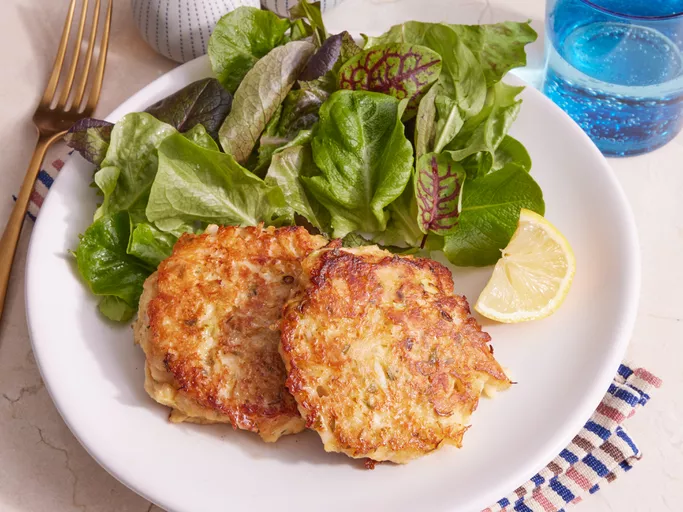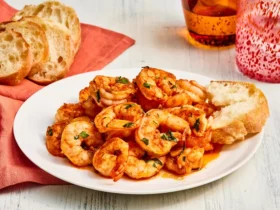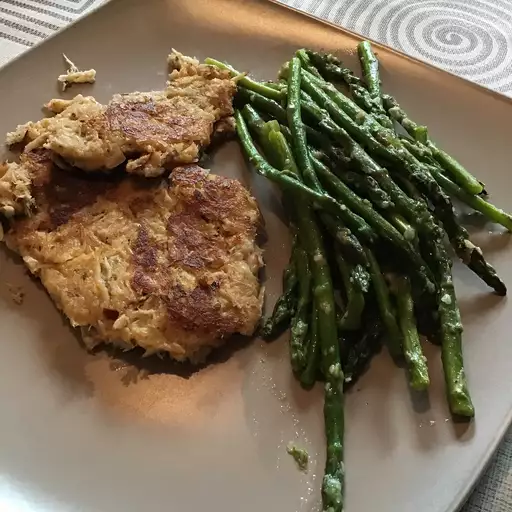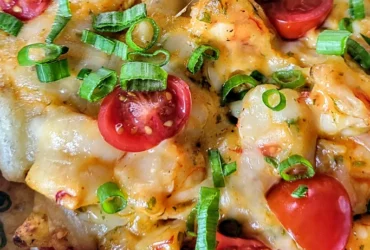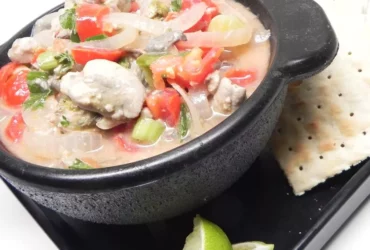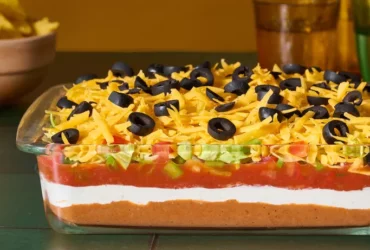Crab Cake Essentials
Selecting the Best Crab Meat
The foundation of any exceptional crab cake lies in the quality of the crab meat used. It’s essential to understand the different types of crab and their characteristics to make an informed selection.
There are several species of crabs, but for crab cakes, you’ll typically want to use blue crab or jumbo lump blue crab meat. Blue crab is prized for its sweet flavor and tender texture. When shopping for crab meat, look for it to be fresh, cold, and stored on ice. Be wary of pre-cooked or previously frozen crab, as it can compromise the texture and taste.
Jumbo lump blue crab is the gold standard for crab cakes. These lumps are large, intact pieces of crab that have not been broken down into smaller flakes. They provide a superior texture and flavor to your cakes. You may also come across lump blue crab meat, which is similar but has some smaller pieces mixed in.
Another option is claw crab meat. While it’s often cheaper than jumbo lump or lump crab, it can be more prone to over-processing and a coarser texture. However, when done correctly, claw crab can still produce excellent results.
When selecting the best crab meat for your crab cakes, make sure to check the label for the following:
- Freshness: Look for a “fresh” or “frozen at sea” label to ensure it hasn’t been previously frozen and thawed. This can lead to texture degradation.
- Storage conditions: The crab meat should be stored on ice to maintain its freshness and prevent spoilage.
- Quality certifications: Opt for certified sustainably caught or harvested crab meat to support responsible fishing practices.
Ultimately, the quality of your crab meat will directly impact the taste and texture of your crab cakes. By choosing jumbo lump blue crab or high-quality lump blue crab, you’ll be well on your way to making the best ever crab cakes recipe.
Jumbo lump crab meat is ideal, but it’s often expensive
- Crab cakes are a delicious and iconic dish that requires some essential ingredients to get it just right.
- When it comes to choosing the best jumbo lump crab meat, it’s a matter of quality over quantity.
- Jumbo lump crab meat is ideal for crab cakes because it has the perfect balance of size and flavor. The larger pieces of crab meat provide a better texture and a more intense flavor, making each bite truly enjoyable.
- However, jumbo lump crab meat can be expensive, which may deter some home cooks from using it in their recipes.
- But the good news is that you don’t have to break the bank to make great-tasting crab cakes. You can also use lump or flaked crab meat as a substitute, although the texture and flavor might be slightly different.
- Regardless of the type of crab meat you choose, it’s essential to handle it gently to avoid damaging the delicate flesh.
- To prepare your crab meat for the recipe, make sure to rinse it under cold water and pat it dry with paper towels before using it in the mixture.
- This will help prevent any excess moisture from affecting the texture of the crab cakes. Now that we have our crab meat, let’s talk about the other essential ingredients for a mouthwatering crab cake recipe.
Claw and body meat can be used as substitutes
The foundation of a superior crab cake lies in the quality and proportion of its ingredients, particularly when it comes to the type and amount of meat used.
Crab cakes are traditionally made with fresh or jumbo lump blue crab meat, but for those seeking substitutes, claw and body meat can be utilized in place of the expensive lumps. Claw meat is taken from the larger, thicker pincer claws of the blue crab, offering a slightly sweeter flavor than the body meat.
Body meat, on the other hand, comes from the smaller muscles inside the crab’s abdomen. While it may not provide the same succulent texture as lumps or claw meat, it has a robust flavor and can still hold together well in a crab cake when combined with sufficient binder and seasonings.
To use these substitute meats effectively, it is essential to note that they tend to have a higher moisture content than jumbo lump blue crab. This means they may release more liquid during cooking, potentially leading to a less cohesive or even loose texture if not managed properly.
One strategy for handling this issue is to incorporate more breadcrumbs and egg in the recipe as binders. Breadcrumbs help absorb excess moisture while providing structural integrity, whereas eggs serve to hold everything together by acting as a sticky matrix that ties the ingredients together.
An additional trick to creating well-formed crab cakes with substitute meats involves incorporating a sufficient amount of panko bread crumbs or finely chopped crackers into the mix. Panko is an excellent choice because it produces a crispy texture when cooked while absorbing excess moisture, thereby helping to stabilize the composition of the cake.
Freshness is key: look for crab with moist, snowwhite meat
When it comes to making the best ever crab cakes, there are a few essential ingredients that you simply can’t skimp on. And at the top of that list is freshness – specifically, the freshness of your crab.
A good crab cake starts with high-quality crab meat, and for that reason, freshness is key. Look for jumbo lump crab meat that has been properly stored and handled to ensure it remains moist and white. The snow-white color is a giveaway of its freshness – if it’s turning yellow or brown, it’s likely past its prime.
When you’re at the seafood counter, inspect the crab meat carefully. It should be plump, firm, and have a pleasant aroma. Avoid buying crab meat that has been sitting out for too long, as this can cause it to become dry and develop off-flavors.
You can also check the packaging for signs of freshness. Look for labels or stickers that indicate when the crab was caught or processed. Ideally, you want to buy crab meat that’s been recently harvested or has a short shelf life.
Remember, fresh crab is worth every penny – it will make all the difference in the flavor and texture of your crab cakes. So don’t skimp on quality when it comes to this essential ingredient. Your taste buds (and your guests) will thank you!
In addition to using fresh crab meat, there are a few other essentials that can elevate your crab cakes to the next level. For example, a good binder is crucial for holding the mixture together – we recommend using panko breadcrumbs or even some finely chopped vegetables like carrots or zucchini.
Seasoning is also key, so be sure to use plenty of Old Bay seasoning (or a combination of paprika, garlic powder, and onion powder) to give your crab cakes that authentic flavor. And don’t forget to add some lemon juice for a squeeze of brightness and acidity.
Finally, the shape and presentation of your crab cakes can make all the difference in their appeal. Try using a ring mold or a cookie scoop to get perfectly rounded patties. You can also top them with some chopped scallions or parsley for added color and freshness.
By following these essentials and tips, you’ll be well on your way to making the best ever crab cakes recipe – one that’s sure to impress your friends and family at any gathering or special occasion!
Prepping Your Crab Cakes
Picking the Right Binders
To achieve the perfect crab cakes, it’s essential to properly prep them before cooking. This involves gently handling the delicate mixture and forming each cake individually.
Here are the steps for prepping your crab cakes:
- Gently mix the crab meat with the other ingredients in a large bowl, being careful not to break up the lumps of crab. Overmixing can result in dense and heavy crab cakes.
- Add any wet ingredients, such as mayonnaise or egg, last and gently fold them into the mixture until just combined.
- Using a light touch, divide the mixture into portions, depending on how large you want your crab cakes to be. Aim for around 1/4 cup of mixture per cake.
- Shape each portion into a round patty, making sure to keep it evenly sized and about 3/4-inch thick.
- Gently place the formed crab cakes onto a parchment-lined baking sheet or a plate, leaving some space between them to allow for even cooking.
Now that your crab cakes are prepped, it’s time to discuss the importance of choosing the right binders. A binder is an ingredient that helps hold the mixture together and adds structure to the finished cake.
Here are some common binders used in crab cakes:
- Panko breadcrumbs: These light, airy breadcrumbs add a delicate texture and help keep the crab cakes moist. They’re also a good option for those with gluten intolerance.
- Regular breadcrumbs: These work well in crab cakes, but be aware that they can make the mixture slightly denser. Use them sparingly to avoid an overly heavy texture.
- Egg whites or egg substitute: Whipped egg whites can add structure and help bind the mixture together. However, use them with caution as overbeating can result in tough crab cakes.
When choosing a binder, consider the type of texture you prefer in your crab cakes. Panko breadcrumbs offer a light, airy texture, while regular breadcrumbs or egg whites will produce a denser cake.
Remember to store any leftover binders in an airtight container and use them within a reasonable timeframe to ensure optimal flavor and texture in your finished crab cakes.
Panko breadcrumbs are preferred due to their light texture
To begin preparing your crab cakes, it’s essential to start with fresh and high-quality ingredients. Freshly picked or store-bought lump crab meat is a must, as it will provide the best flavor and texture for your crab cakes.
Mixing the crab meat with other ingredients such as mayonnaise, mustard, and spices is crucial to binding the mixture together and adding flavor. However, it’s essential not to overmix, as this can lead to a dense and rubbery texture in the finished crab cake.
Next, when choosing breadcrumbs, Panko breadcrumbs are preferred due to their light texture. Regular breadcrumbs can weigh down your crab cakes, making them dense and heavy. Panko breadcrumbs will provide a lighter, crisper coating that complements the delicate flavor of the crab meat perfectly.
To incorporate the Panko breadcrumbs into your mixture, simply add them towards the end of the mixing process. This ensures that you don’t overmix the breadcrumbs into the crab meat, which can lead to an unpleasant texture in the finished product.
Forming the crab cakes is also a crucial step in preparing your Best Ever Crab Cakes Recipe. To achieve perfectly round and symmetrical crab cakes, use a ring mold or a small scoop to portion out the mixture evenly. Gently press each portion down into a flat disc shape to ensure that they hold their shape while frying.
Chilling your formed crab cakes in the refrigerator for at least 30 minutes before frying will help them retain their shape and texture during cooking. This step is crucial, as it allows the flavors to meld together, and the breadcrumbs to absorb any excess moisture from the crab meat.
When you’re ready to fry your crab cakes, heat a small amount of oil in a non-stick pan over medium-high heat. Gently place each chilled crab cake into the hot oil, leaving space between them for even cooking. Cook for 3-4 minutes on each side or until they’re golden brown and crispy.
Serve your perfectly prepared crab cakes with a tangy remoulade sauce, coleslaw, or tartar sauce to complete your Best Ever Crab Cakes Recipe. Enjoy!
Old Bay seasoning adds a distinctive flavor profile
The key to making exceptional crab cakes lies in the preparation and quality of ingredients, particularly when it comes to the seasoning used. Old Bay is a staple in Maryland and a crucial component in many recipes for crab cakes. The distinctive flavor profile provided by Old Bay seasoning is a result of its unique blend of herbs and spices.
The origins of Old Bay seasoning can be traced back to the early 20th century when it was first introduced as a way to season seafood. Over time, it has become an integral part of Maryland’s culinary identity, particularly in dishes like crab cakes.
To prep your crab cakes effectively, start by making sure you have fresh and high-quality ingredients on hand. This includes genuine Lump Crab Meat, which will provide the best texture and flavor for your crab cakes.
The next step is to prepare the filling for your crab cakes. In a medium-sized bowl, gently combine the Lump Crab Meat, mayonnaise, Dijon mustard, Worcestershire sauce, Old Bay seasoning, and chopped scallions until well combined.
Be careful not to overmix the filling, as this can result in tough crab cakes that fall apart easily. Once you have reached the desired consistency, cover the bowl with plastic wrap and refrigerate for at least 30 minutes to allow the flavors to meld together.
Once your filling has had time to rest, it’s time to shape your crab cakes into patties. Using a small ice cream scoop or spoon, portion out the mixture onto a plate or tray. Gently press each portion into a crab cake mold or form them by hand into patties.
It’s essential to note that you should not overhandle the mixture at this stage, as it can cause the crab cakes to become dense and lose their delicate texture. Instead, use a light touch when shaping each patty to ensure they retain their natural shape and appearance.
To prepare your crab cakes for cooking, heat about 1/2 inch of oil in a large skillet over medium-high heat until it reaches shimmering. Carefully add the crab cakes to the hot oil in batches if necessary, being mindful not to overcrowd the pan. Cook each batch for about 4-5 minutes on the first side or until they are golden brown and crispy.
Flip the crab cakes over and cook for an additional 3-4 minutes or until they reach your desired level of browning and crispiness on both sides. Repeat this process with the remaining batches, adjusting the heat as needed to prevent burning or oil splatters.
Serve your perfectly cooked crab cakes immediately, garnished with a sprig of fresh parsley or lemon wedges if desired. Enjoy the rich and savory flavors that come together in each delicious bite, thanks to the Old Bay seasoning and high-quality ingredients used throughout this best-ever crab cakes recipe.
Some recipes use eggs or mayonnaise as binders, but they can make cakes dense
To prepare the most delicious crab cakes possible, it’s essential to take a few key steps before actually mixing and forming the patties.
The first step is to make sure you’re using high-quality ingredients, particularly when it comes to the fresh lump crab meat. Look for jumbo lumps or jumbo lump backfin crab meat, as these will provide the best flavor and texture.
Next, you’ll want to gently pick through the crab meat to remove any bits of shell or cartilage that might be present. This is a crucial step in ensuring that your crab cakes are not only delicious but also visually appealing.
Now it’s time to think about how you can create a binding agent for your crab cakes without relying on eggs or mayonnaise, which can make the patties dense and heavy-tasting. A great alternative is to use panko breadcrumbs mixed with a bit of chopped fresh parsley and some lemon zest.
Mixing the panko crumbs with herbs and citrus adds flavor and texture while also helping to bind the crab meat together without adding extra moisture or weight.
Another option for binding your crab cakes is to use a bit of grated onion mixed in with the crab meat. This will not only add flavor but also help to hold the mixture together nicely.
It’s also essential to handle the crab meat gently when mixing it with other ingredients, as over-handling can cause the lumps to break down and become dense and unappetizing.
To prepare your crab cakes for baking or pan-frying, place a small scoop of the mixture onto a flat surface and gently shape into a round or oval patty. Don’t press too hard on the mixture as you’re forming the patties – this can cause them to become dense and lose their delicate flavor.
Once your crab cakes are formed, they’re ready to be coated with additional panko breadcrumbs mixed with seasonings for an extra crispy exterior. This is where the magic happens, and your crab cakes will truly start to shine!
Bake or pan-fry your crab cakes according to your preference, but make sure to keep them nice and golden on both sides for maximum flavor and texture.
- Best Datanyze Alternatives for 2025 - April 24, 2025
- Best Hunter.io Alternatives for 2025 - April 22, 2025
- Best Lead411 Alternatives for 2025 - April 22, 2025

